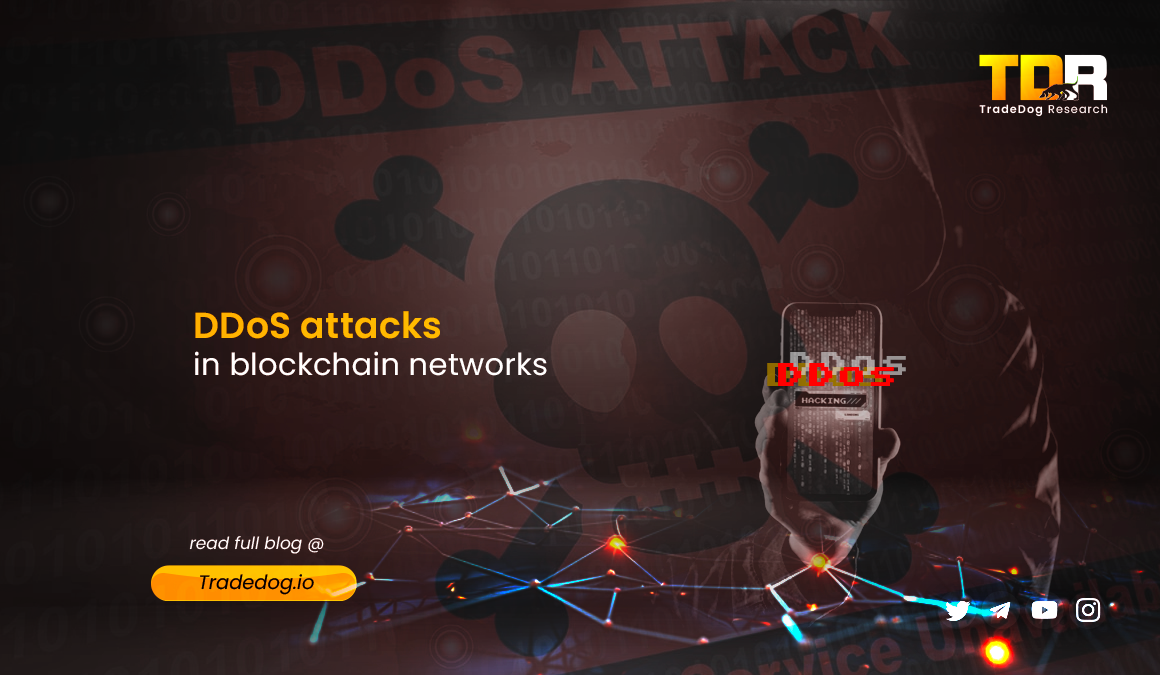Quick Links
Imagine you’re trying to access a website, but it’s painfully slow or completely crashes. This frustrating experience could be the result of a DDoS attack, a malicious attempt to overwhelm a system with traffic, rendering it unavailable to legitimate users. While traditionally targeted at websites, DDoS attacks can also disrupt blockchain networks, albeit in different ways.
Understanding DDoS Attacks
DDoS attacks aim to overwhelm a system with a surge of internet traffic, rendering it unavailable to genuine users. Attackers typically achieve this by compromising a vast network of internet-connected devices, known as a botnet. These compromised devices, which can include personal computers, servers, or even Internet of Things (IoT) gadgets, are then instructed to bombard the target system with requests simultaneously. The sheer volume of traffic can overload the target’s resources, such as bandwidth, processing power, and memory, causing it to slow down or crash entirely.
DDoS attacks come in various forms, each targeting different vulnerabilities:
- Volumetric attacks: These attacks flood the target network with a massive amount of data, overwhelming its bandwidth and preventing legitimate traffic from reaching its destination.
- Application attacks: These attacks target specific weaknesses in the application layer, aiming to exhaust its resources and disrupt its functionality.
- Protocol attacks: These attacks exploit flaws in the underlying communication protocols, disrupting the normal flow of data exchange.
- TCP connection attacks: These attacks establish a large number of half-open connections with the target server, consuming resources and preventing legitimate connections from being established.
- Fragmentation attacks: These attacks send data packets in fragmented pieces, making it difficult for the target system to reassemble and process the information correctly, leading to performance degradation.
DDoS Attacks in Blockchain Networks
Blockchain networks, with their decentralized nature, offer inherent resilience against traditional DDoS attacks that target a single point of failure. Since blockchain transactions are validated and processed by a distributed network of nodes, compromising a single node wouldn’t cripple the entire network. However, this doesn’t make them entirely immune to DDoS attacks.
Blockchain DDoS attacks typically focus on disrupting the protocol layer rather than individual nodes. Here are some prevalent methods employed by attackers:
- Transaction Flooding: Blockchains process transactions at a predetermined rate, with each block having a limited capacity. Hackers can exploit this by flooding the network with a massive number of invalid or spam transactions. This clogs the network, preventing legitimate transactions from being processed and slowing down the entire system.
- Smart Contract Attacks: Smart contracts are self-executing programs on a blockchain that can automate tasks. Hackers can target vulnerabilities in smart contracts by sending transactions designed to consume excessive resources. These complex transactions can overload the network, causing delays and disruptions similar to transaction flooding.
- Software Crashes: Blockchain core applications have limitations on transaction processing and storage capacity. A sudden surge of transactions from a DDoS attack can overwhelm this software, causing unexpected behavior or even crashes. This can disrupt network operations and hinder transaction processing even further.
- Node Failures: Blockchain networks rely on individual nodes (validators or miners) running the core software. During a DDoS attack, these nodes are bombarded with massive amounts of junk data. If the attack is strong enough, a node can run out of memory or processing power, leading to a crash. A single node failure puts additional strain on the remaining nodes, potentially creating a domino effect and causing cascading failures.
The Impact of DDoS Attacks on Blockchain Networks
DDoS attacks can have a significant negative impact on blockchain networks in several ways:
- Slowed Transaction Processing: The influx of spam transactions can significantly slow down the processing of legitimate transactions, frustrating users and hindering business operations.
- Network Congestion: The surge in traffic can overwhelm the network’s bandwidth, making it difficult for nodes to communicate and maintain consensus.
- Node Failures: In extreme cases, the sheer volume of traffic can overload individual nodes, causing them to crash or malfunction. This can disrupt the network’s overall functionality.
- Bloated Ledger: Transaction flooding attacks can permanently bloat the blockchain ledger with useless data, increasing storage requirements for nodes.
Blockchain DDoS Attacks in Real World
DDoS attacks are not just theoretical threats. Several real-world incidents highlight their disruptive capabilities:
- September 14, 2021: The Solana blockchain, known for its high transaction throughput, came under a DDoS attack that bombarded the network with a staggering 400,000 transactions per second (TPS). This overwhelming surge overloaded the network, causing a service outage for several hours. The severity of the attack even necessitated a network rollback, where validators agreed to revert to a previous state of the blockchain.
- September 14, 2021 (coincidence?): Arbitrum, another blockchain platform, also faced a DDoS attack on the same day. The attack targeted the Sequencer, a component responsible for ordering transactions. The influx of transactions overloaded the Sequencer, leading to a network outage for roughly 45 minutes. While Arbitrum offered a temporary workaround through the Ethereum chain, the attack highlighted the vulnerability of specific components within a blockchain network.
Defending Against DDoS Attacks
While DDoS attacks pose a threat, there are measures that can be taken to strengthen blockchain networks and make them more resilient:
- Node Hardening: Ensuring nodes have adequate processing power, storage capacity, and network bandwidth is crucial. This allows them to handle higher volumes of traffic and resist overload attempts.
- Secure Smart Contract Development: Implementing strong security practices during smart contract development can help prevent vulnerabilities that attackers can exploit for DDoS purposes.
- Network-Level Security: Firewalls and intrusion detection/prevention systems (IDS/IPS) can be deployed at the network level to identify and mitigate DDoS attacks. Content delivery networks (CDNs) can also help distribute and absorb attack traffic.
- Regular Audits and Stress Testing: Regularly auditing smart contracts and the blockchain’s codebase can help identify and patch vulnerabilities before they are exploited. Stress testing the network can simulate DDoS attacks and assess its ability to withstand them.
- Redundancy and Backups: Implementing redundant network infrastructure and backup servers can ensure that the system remains operational even during an attack. Distributing nodes across various geographical locations can further mitigate the impact of regionally targeted DDoS attacks.
Conclusion
DDoS attacks pose a significant threat to the stability and usability of blockchain networks. By understanding how these attacks work and implementing appropriate security measures, blockchain developers and network operators can build more resilient systems that can withstand malicious attempts to disrupt their operations. As the use of blockchain technology continues to grow, developing robust defense mechanisms against DDoS attacks will be critical for ensuring the secure and reliable operation of these decentralized networks.









